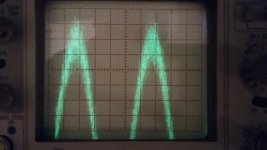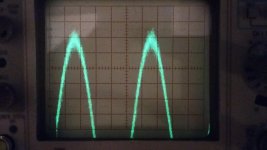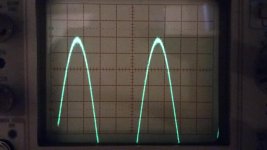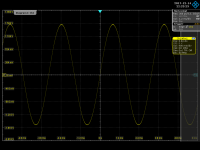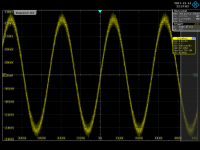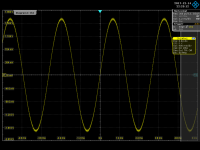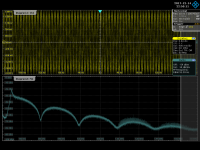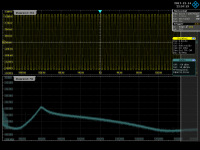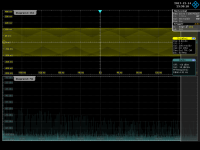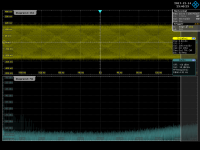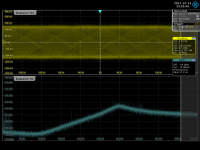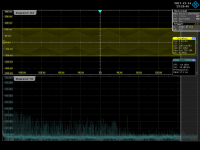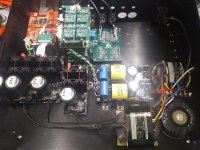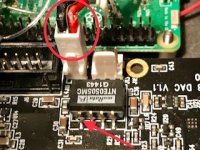Anand,
First of all... : merry Xmas to all!
After the most important part..
I like your question.. It was coming to mind also to me.
So I did a little trip around, tried to have a look by other means at my disposal.
First I was curious if the observed noise floor behaviour can be confirmed..
So as a first approach, had taken some analog scope shots.
Old tek scopes cannot lie!
The first shot is DSD 64, the second is DSD 128, third is DSD 256.
The same test signal as from those in post1475; 76
First of all... : merry Xmas to all!
After the most important part..
I like your question.. It was coming to mind also to me.
So I did a little trip around, tried to have a look by other means at my disposal.
First I was curious if the observed noise floor behaviour can be confirmed..
So as a first approach, had taken some analog scope shots.
Old tek scopes cannot lie!
The first shot is DSD 64, the second is DSD 128, third is DSD 256.
The same test signal as from those in post1475; 76
Attachments
The same scope trace shots again but with a bit more sophisticated tool
First is pcm 384kHz, 24bit (as upsampled in HQplayer from the original 96kHz /24 bit signal)
Then the same signal but upsampled to DSD 128; finally DSD 256 (using DSD7 modulator)
First is pcm 384kHz, 24bit (as upsampled in HQplayer from the original 96kHz /24 bit signal)
Then the same signal but upsampled to DSD 128; finally DSD 256 (using DSD7 modulator)
Attachments
Thank you for that. It’s a pity you are not located in the USA, as I would forward my dac to you for measurements!
That being said, it will probably measure similarly however my version has the Weiss OP-BP2’s in the output stage (4 modules, differential
output).
Merry Xmas!
Best,
Anand.
That being said, it will probably measure similarly however my version has the Weiss OP-BP2’s in the output stage (4 modules, differential
output).
Merry Xmas!
Best,
Anand.
As visible, the signal is showing the artefacts of the different modulation schemes in the upsampling & noise shaping process. DSD256 upsampling is pushing the noise peak further out above the audio range, and the overall noise load in total is also less.
Finally, here it is a closed-in comparison of the same signal (-20dB 96kHz/24bit test signal) as reproduced by the Mirand dac (V 1.1, modded) as 1.)pcm 384kHz processing 2.) Upsampling to DSD256
Finally, here it is a closed-in comparison of the same signal (-20dB 96kHz/24bit test signal) as reproduced by the Mirand dac (V 1.1, modded) as 1.)pcm 384kHz processing 2.) Upsampling to DSD256
Attachments
Last edited:
Thank you for that. It’s a pity you are not located in the USA, as I would forward my dac to you for measurements!
That being said, it will probably measure similarly however my version has the Weiss OP-BP2’s in the output stage (4 modules, differential
output).
Merry Xmas!
Best,
Anand.
Hah.. did You strap those from the hands of Mike?! Or you did buy the Mivera dac altogether..
By the way, the mods I did are getting quite much in that direction ( cleaner clock feed, NDK SDA clocks, and some other ..)
Ciao, George
Last edited:
After all this detour..
My attempt at answering would be: I trust very much the results from the AK4396A as implemented in my soundcard. It is showing very close performance to the RTX analyzer.
One factor that can influence the ADC sampling is if high frequecy added noise is so agressive that it can get through the input low pass HW filters and provoces aliasing in the output data.
As visible something like that happens indeed at lower DSD sampling rates; at and above DSD 256 instead the rise in the modulator's noise gets pushed out so far above 96kHz that the ADC input filters are getting effective again. So I think the data becomes reliable as usual from this card.. (the EMU1616m)
Ciao, George
are your DSD measurements valid?
My attempt at answering would be: I trust very much the results from the AK4396A as implemented in my soundcard. It is showing very close performance to the RTX analyzer.
One factor that can influence the ADC sampling is if high frequecy added noise is so agressive that it can get through the input low pass HW filters and provoces aliasing in the output data.
As visible something like that happens indeed at lower DSD sampling rates; at and above DSD 256 instead the rise in the modulator's noise gets pushed out so far above 96kHz that the ADC input filters are getting effective again. So I think the data becomes reliable as usual from this card.. (the EMU1616m)
Ciao, George
Hah.. did You strap those from the hands of Mike?! Or you did buy the Mivera dac altogether..
By the way, the mods I did are getting quite much in that direction ( cleaner clock feed, NDK SDA clocks, and some other ..)
Ciao, George
Dac kit from Mike. That being said, it took a lot out of me to purchase the kit, since the design was devoid of any measurements. There were measurements of the Weiss discrete OP, the Belleson regulators, etc...but no measurement of the ENTIRE design from USB input to differential XLR output. Your postings regarding the performance of this dac with a DSD 256 signal is a breath of fresh air and a voice of certainty. Anytime I asked for data, Mike would get defensive and just relay subjective quotes from the multitude of owners of his “Mivera” design instead. They all of course said it sounded amazing.
I believe there is a world where exacting measurements, a respect for psychoacoustic research and subjective evaluations that corroborate the exacting measurements can coexist.
Best,
Anand.
Dac kit from Mike. That being said, it took a lot out of me to purchase the kit, since the design was devoid of any measurements. There were measurements of the Weiss discrete OP, the Belleson regulators, etc...but no measurement of the ENTIRE design from USB input to differential XLR output. Your postings regarding the performance of this dac with a DSD 256 signal is a breath of fresh air and a voice of certainty. Anytime I asked for data, Mike would get defensive and just relay subjective quotes from the multitude of owners of his “Mivera” design instead. They all of course said it sounded amazing.
I believe there is a world where exacting measurements, a respect for psychoacoustic research and subjective evaluations that corroborate the exacting measurements can coexist.
Best,
Anand.
There was measurements, but my equipment does not have low enough noise floors. And as you see the noise floor on the DSD is higher than on the PCM signal which was hard for Mike to accept.
Dac kit from Mike. That being said, it took a lot out of me to purchase the kit, since the design was devoid of any measurements. There were measurements of the Weiss discrete OP, the Belleson regulators, etc...but no measurement of the ENTIRE design from USB input to differential XLR output. Your postings regarding the performance of this dac with a DSD 256 signal is a breath of fresh air and a voice of certainty. Anytime I asked for data, Mike would get defensive and just relay subjective quotes from the multitude of owners of his “Mivera” design instead. They all of course said it sounded amazing.
I believe there is a world where exacting measurements, a respect for psychoacoustic research and subjective evaluations that corroborate the exacting measurements can coexist.
Best,
Anand.
Filter bandwidth is ~116KHz +/-2KHz depending on gain.
The picoscope has artifacts (Especially at around 350KHz) But that has nothing to do with the signal.
On the 17.23dBu signal it corresponds to a noise floor of 120dB below the signal.
3rd shot is HQ player. (Limited to 5.6MHz due to test on Windows machine)
Attachments
-
mivera 1KHz 0dB 88.2KHz 1MHz FFT.pdf87.4 KB · Views: 86
-
mivera 1KHz 17.23dBu out 88.2KHz 1MHz FFT 6Vrms.pdf87 KB · Views: 35
-
mivera 1KHz ASDM5 poly-sinc-shrt-2s.pdf106.3 KB · Views: 101
-
mivera 1KHz DSD5V2 poly-sinc-shrt-2s.pdf 1MHz sweep.pdf98.8 KB · Views: 43
-
mivera 1KHz dsd7 poly-sinc-shrt-2s.pdf106.5 KB · Views: 110
-
mivera 1KHz dsd7a poly-sinc-shrt-2s.pdf106.6 KB · Views: 106
Hi Vitalica,
Very nice build!!!
Do
Thanks Domenic
I'm surprised how well Renderer now sounds after I have separately powered the Clock and MR-MOD Ethernet Media Renderer Modules on the Renderer board.
I thought this would be OK to do it in DAC V1.1.
But I probably have not asked a correct question and Sonny will not answer me. I think Clock on DAC already has separate power.
Anyway, the sound is fantastic!
Thanks Domenic
I'm surprised how well Renderer now sounds after I have separately powered the Clock and MR-MOD Ethernet Media Renderer Modules on the Renderer board.
I thought this would be OK to do it in DAC V1.1.
But I probably have not asked a correct question and Sonny will not answer me. I think Clock on DAC already has separate power.
Anyway, the sound is fantastic!
It is not an easy question as the answer is difficult.
- Home
- Vendor's Bazaar
- AK4490 USB Dac with dsd support.
